
|
|
HomePort  |
|
Rev. John Redford
Scott (1909-1958)
|
|
|
John Redford Scott was born in 1909 in the
farming community of Ste. Croix, Nova Scotia where the ancestral
roots of both his parents ran deep. 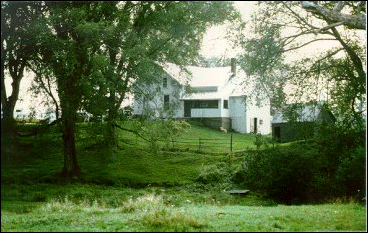 The son of Lillian Jane Harvey (1870-1939)
and John Albert Scott (1866-1954) young
Jack, as he was always known, along with younger brother Fred,
grew up on Elm Farm, a 200 acre property that had been home to
four generations of the family. Their mother, a nurse and midwife, had returned from a career in Boston, and
their father a farmer and community
leader, encouraged the boys in their studies. The
property comprised of fertile dyke land, rolling upland fields
and wooded hills to the back surrounds a meandering brook
flowing into a lake which forms the pasture's edge. Today the
property continues to be enjoyed by new generations of Scotts.
The son of Lillian Jane Harvey (1870-1939)
and John Albert Scott (1866-1954) young
Jack, as he was always known, along with younger brother Fred,
grew up on Elm Farm, a 200 acre property that had been home to
four generations of the family. Their mother, a nurse and midwife, had returned from a career in Boston, and
their father a farmer and community
leader, encouraged the boys in their studies. The
property comprised of fertile dyke land, rolling upland fields
and wooded hills to the back surrounds a meandering brook
flowing into a lake which forms the pasture's edge. Today the
property continues to be enjoyed by new generations of Scotts.
Although it was his brother Frederic Charles
Gillmore Scott (1911-2010), who gained the namesake and a strong
social conscience, it was Jack who inherited the Gillmore mantle
and embraced enthusiastically a life of Christian service through ministry. He
was one of over a dozen Gillmore descendants ordained to
ministry in various denominations.
The village of Ste. Croix was made up of a series of farms surrounding a bridge over the Ste. Croix River which powered several mills over time and still generates electricity. The Scott family like many within the area were a temperance family, with Jack's father serving as Grand Worthy Patriarch in the Sons of Temperance provincial organization. He held strong views on the effects of alcohol and was prepared to challenge others regarding the best way to minimize the negative effect legalization of alcohol was having on alcoholics. Possibly the fact that Jack's great grandfather had been left without a father in a murder committed by "a drunk" had a defining effect on the family; both Jack and Fred were raised during a time when Temperance was a strong social cause and taking "the pledge", to abstain from alcohol was a rite of passage within the temperance clubs organized for young people. While easily abandoned once away from home for other young people, the commitments made in their youth were very real to the brothers and maintained throughout their lifetimes. Jack's pledge signed at the age of eight remained framed and a central part of his life.
After completing grade school in the
village, Jack began the daily walk of two miles to Newport
Corner where he would catch a train to Windsor and then walk
another mile to attend high school at Windsor Academy. There he
joined the cadet corps. Often he and his brother would get
a ride with the mailman who travelled to the train station by
horse and wagon. As "country students" had all the uncertainty
of winter travel thus would often arrived late and worked hard
to keep up with the class. Jack's brother quickly learned that
education could be a luxury when the needs of a busy farm and an
ill father ended his schooling, and launched an early start at a
lifetime of farming.
A keen student, Jack excelled in school and
decided to continue his education at Acadia University in
Wolfville, where he majored in Economics, winning a gold medal
of distinction at graduation as well as an Acadia Gold A.
His undergraduate years were marked by his all-round ability
that saw him compete in track & field and lead Acadia's
debating team to international victory. Elected to various
leadership roles in student organizations, he was known as a
serious student who was not wasting either time or money in his
pursuit of a solid education. During the year he worked as a
campus dining hall waiter and in the summers he worked as a
waiter with Canadian National Railways. His debating ventures were
well documented and lauded by Nova Scotia newspapers which
called him a "natural orator" after successive wins
over Canadian teams led to an international debate in which he
and his debating partner achieved a win over their American
rivals. 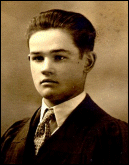 Well liked
and respected by his peers he was elected class valedictorian by
the Acadia class of 1930.
Well liked
and respected by his peers he was elected class valedictorian by
the Acadia class of 1930.
Upon graduation, he taught for two years at
Institut Feller, a Protestant private school in Grande-Ligne,
Quebec. Still quite youthful in appearance and barely older than
his students, his new moustache was possibly an effort to ensure
his students knew who the teacher was. He became involved with
drama productions and he kept in touch through letters with
college friends who were making decisions about their
careers. Knowing his oratorical ability, his friends asked
whether it would eventually be law or economics in his
future. His letters reveal his growing social conscience
during the Great Depression and his conviction that churches had
a vital role in communities and in the lives of people.
Always active in his own church and Christian organizations on
campus; with a genuine concern for people, Jack found himself
drawn to ministry in the United Church of Canada. In 1932
he returned to his native province to enrol in Theology at Pine
Hill Divinity Hall, in Halifax, NS on the campus of what became
the Atlantic School of Theology.
During the summer, his student ministry was at Clam Harbour, N.S. in 1933 and DeBolt in northern Alberta in 1934 where he discovered the ministry needs of the pioneers of the developing North. His notes mention a log church and manse, and travelling by saddle horse. He wrote of the needs of the hard working people who had little of the shared history and culture that he took for granted in Nova Scotia and of the hardships both physical and mental endured by these pioneers clearing land and forging new communities out of wilderness. As part of church policy to ensure that student ministers experienced the diverse regional needs with Canada, his summer in the DeBolt had taught him of the genuine needs of the pioneers attempting to earn a living from rugged conditions.
Upon ordination by the United Church of
Canada in 1935 he accepted a posting back to the Peace River
District of northern British Columbia. This time it was a bit
further west of DeBolt in Dawson Creek. Known as "the end of the
steel," the Northern Alberta Railway had just arrived four years
earlier, and the congregation had recently built a church.
The vast pioneer area required a horse to reach tiny
congregations in Willow Valley, Progress, South Dawson,
Devereau, Bon Accord, and Sunrise Valley. Confiding to his
father in letters home he talked of the differing values he saw
in the frontier town compared to his own temperance home. Dawson
Creek had a beer parlour and lots of Sunday sports, yet was
quite a peaceful town. He lived in the Red Apple Hotel until a
building was moved onto church property as a manse, and took his
meals with the bachelors at a local boarding house to save
money.
He wrote of the wonderfully faithful people working to build
their small congregations in this rugged northern land.
"It is they on whom future generations will lavish praise for the farms they wrested from the virgin country."
His records of church attendance for each
location show that often the smaller congregations would have
between five and ten in attendance while Dawson Creek had twenty
to thirty most Sundays with a peak once of seventy-two. He
discussed with his "Poppa" by letter the qualities of a suitable
saddle horse. After trying out a smaller one he finally bought a
big red, friendly horse called Rusty for $55 and a saddle
originally built for the Alberta Provincial Police. Although
army surplus saddles sold for $10 he was advised locally to buy
the $25 police saddle as it would give some protection during
the northern winter. With a wilderness charge that was
forty miles long he prepared well. His letter described a
typical Saturday.
"I go to Willow Valley 36 miles from town. I speak there Saturday evening, then after service ride this way 12 miles. Then on my way in on Sunday, have two services, and a third one in town Sunday".
Decked in leather Wellington 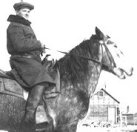 boots and a long riding coat for protection from
the weather he looked more the image of a western rancher than a
clergyman. A farm boy at heart, he adapted to the northern
conditions, including night riding in the dark and his life as a
horseback pastor easily. One letter tells of travelling through
the woods late at night and attempting to unsaddle Rusty and get
him into a corral when there was no moonlight and no flashlight.
Feeling his way along he was relieved to finally get Rusty
safely into the corral and himself into the cabin when he
reached his destination.
boots and a long riding coat for protection from
the weather he looked more the image of a western rancher than a
clergyman. A farm boy at heart, he adapted to the northern
conditions, including night riding in the dark and his life as a
horseback pastor easily. One letter tells of travelling through
the woods late at night and attempting to unsaddle Rusty and get
him into a corral when there was no moonlight and no flashlight.
Feeling his way along he was relieved to finally get Rusty
safely into the corral and himself into the cabin when he
reached his destination.
After completing two years in Dawson Creek
he returned to Nova Scotia where he served from 1937 to 1940 in
Walton a community within his native Hants County which also
included congregations in Brookville, Cheverie, Pembroke,
Tenecape, and Bramber. Trading his horse for a bicycle, he
managed to serve his congregations using pedal power until he
could pay some of his college debts and purchase a second-hand
car. Having motorized transportation also meant he could
more easily visit his widowed father and his brother at
home. He next served from 1940 to 1942 in Economy and
Lower Five Islands, nearby coastal areas on the scenic Bay of
Fundy.
During World War II, he grew
increasingly concerned for the ministry needs of Canadians in
military service and in 1942 he joined the Canadian Navy serving
in Halifax. 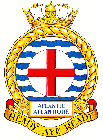 In December
1943 he was transferred from Halifax to St. John's Newfoundland
where he was based for two years. Although occupied with
the counselling and ministerial duties in each naval base, he
insisted on fully knowing the dangers faced by all those at sea
in the Battle
of
the Atlantic, in the daily effort of Allied escort convoys
of military and civilian ships, attempting to survive the deadly
German submarine attacks. His personnel file obtained from the
Navy, and an interview of his supervising officer show his
requests to personally experience the reality of life at sea, in
order to better understand the people he served.
In December
1943 he was transferred from Halifax to St. John's Newfoundland
where he was based for two years. Although occupied with
the counselling and ministerial duties in each naval base, he
insisted on fully knowing the dangers faced by all those at sea
in the Battle
of
the Atlantic, in the daily effort of Allied escort convoys
of military and civilian ships, attempting to survive the deadly
German submarine attacks. His personnel file obtained from the
Navy, and an interview of his supervising officer show his
requests to personally experience the reality of life at sea, in
order to better understand the people he served.  In 1944, he was granted his
request and saw active service in the Mid-Ocean Escort Force, in
the most dangerous portion of the Atlantic on both the HMCS
Napanee and HMCS Halifax. Later a newspaper reporting his
location only as "a Newfoundland port" for security reasons,
told of his visit with Canadians in Britain slated for action in
the invasion of Europe
In 1944, he was granted his
request and saw active service in the Mid-Ocean Escort Force, in
the most dangerous portion of the Atlantic on both the HMCS
Napanee and HMCS Halifax. Later a newspaper reporting his
location only as "a Newfoundland port" for security reasons,
told of his visit with Canadians in Britain slated for action in
the invasion of Europe
"They were a high-spirited lot and at first glance you'd imagine they didn't have a care in the world, but I soon realized that most of them had done a lot of quiet thinking. Those boys know what prayer means."
While in St. John's he was introduced in September 1944 to a fellow Acadia graduate who had earned a university degree at the age of nineteen before returning to Newfoundland to teach. Both now in their thirties with similar interests, they quickly discovered a natural affection for each other. Soon Jean White and Jack would become the love of each other's life, and in May of 1945 a married couple. Jean was musical, outgoing and extremely bright - she saw herself as a "help mate" in his ministry, sharing her talents willingly.
Although peace with Germany was achieved during their honeymoon in Holyrood, Newfoundland, Jack knew the need for his ministry within the Navy was not over and that he would continue to serve. Within nine days of their wedding he had volunteered for the continuing campaign against Japan. Although he was prepared to serve, and had an outstanding request for transfer to the Pacific fleet, the needs of the navy changed quickly as Canada moved to demobilization in Europe.
Awaiting the Pacific transfer, the newlyweds
spent over one year in Halifax at Stadacona naval base where
there remained a need for his services. Peace with Japan was
achieved in August 1945, and in 1946 the young couple became
proud parents of Ruth their first daughter. Jean and Ruth
moved to Elm Farm in Ste. Croix with Jack's brother Fred and
father when the October 1946 transfer to HMCS Uganda in
Esquimalt, British Columbia was finalized. Ironically while Jack
had been among the first Canadian veterans to re-volunteer he
would be posted to a ship which had gained notoriety as the only
ship that had "voted itself out of the war" when in 1945 after
Germany's surrender the majority of the crew did not sign
volunteer papers to enter the Japanese conflict. The event now
understood by naval historians as just a tired crew for whom the
real war was over, had labelled the once proud Canadian ship
with a stigma of disloyalty and it was renamed following a
refit. When Jack arrived by train, the ship still had the older
name and the crew was involved 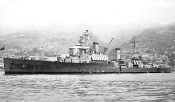 in peace time duties in Canada. As the
cooler weather arrived operations moved gradually southward and
they sailed to California and as far south as Panama. Docking in
California several times allowed him to meet his only first
cousins and cultivated an interest in family history that had
begun as a young man. His service as a padre was captured in a
performance review:
in peace time duties in Canada. As the
cooler weather arrived operations moved gradually southward and
they sailed to California and as far south as Panama. Docking in
California several times allowed him to meet his only first
cousins and cultivated an interest in family history that had
begun as a young man. His service as a padre was captured in a
performance review:
"This Chaplain has a great capacity for remembering names and faces; is well read and is able to discuss a wide variety of subjects. He has shown great devotion to his work and is always willing to do anything extra, cheerfully. His work here has mostly been in ships and he has been particularly diligent in keeping in touch with the men he meets. He has shown keen understanding and sympathy in dealing with men's problems."
Jack and Jean began a letter writing relationship during the year they were on alternate sides of the continent that documented their love and longing to be reunited. Often writing daily, their letters usually crossed, but they maintained close contact as they planned their future together. A collection of several hundred letters, which they both saved, attests to their mutual devotion and writing abilities.
Discharged after five year service in 1947,
Jack and Jean along with Ruth sailed aboard the RMS Queen Mary
out of New York harbour on one of its' 1001 Atlantic crossings.
Heading for Scotland, Jack had registered to do post-graduate
study in theology for two years at New College, University of
Edinburgh, the very school where his great-great-great
grandfather George Gillmore, had begun his ministry two
centuries before. 
The young family made life-long friends, and settled into Scottish life as married students. They welcomed a second daughter, Lillian in 1948. Most Sundays, Jack would travel to Presbyterian churches around the Edinburgh area that needed his services as pulpit supply. The part-time work supplemented the income for the young family and keep him in touch with the life of local congregations.
Although there had been a history of Nova Scotians returning from Edinburgh after two years with a PhD ready to teach at Pine Hill, (his seminary), Jack made a conscious decision not to pursue an academic career and thus chose practical ministry courses that would be of value in his pastoral work at home rather than an advanced academic degree. His professors included Dr. James Stuart Stewart, still celebrated as one of the great Christian writers and preachers of his era.
After a quick visit to the continent
including a visit to Rome for Jack and Jean, the young family of
four returned to Canada in 1949 aboard the comfortable but aging
RMS Aquitania 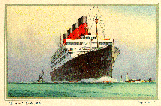 during its' final year of service.
They headed for New Brunswick where Jack had accepted a call to
Salisbury which included Coverdale, Colpitts Settlement, and
Steeves Memorial Churches. While in Salisbury, a third child,
Ian was born. After two temporary houses, the growing family
happily moved into a new manse that had been built during their
years in Salisbury. It was also while in New Brunswick that Jack
re-established his connection with Naval service, becoming a
padre in the Naval Reserve from 1949, in addition to his
pastoral work.
during its' final year of service.
They headed for New Brunswick where Jack had accepted a call to
Salisbury which included Coverdale, Colpitts Settlement, and
Steeves Memorial Churches. While in Salisbury, a third child,
Ian was born. After two temporary houses, the growing family
happily moved into a new manse that had been built during their
years in Salisbury. It was also while in New Brunswick that Jack
re-established his connection with Naval service, becoming a
padre in the Naval Reserve from 1949, in addition to his
pastoral work.
In 1956 Jack accepted a call from a Cape
Breton congregation, Greenwood United Church, in Baddeck where
the family settled for the next two years. Although only in his
forties Jack had started to develop angina, an indicator of
heart disease; on May 30, 1958, Jack Scott died in hospital
while receiving treatment for heart disease, at the age of 49.
With a family and congregation deeply 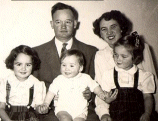 saddened, a much loved minister, husband,
brother, and father was buried in Ste. Croix with full military
honours.
saddened, a much loved minister, husband,
brother, and father was buried in Ste. Croix with full military
honours.
Despite great
losses, and the changes they bring, families do find ways to
continue and Jack's family carried on in the spirit of trust
that he had always shown. After a year living with maternal
relatives in Newfoundland, they chose to settle in Wolfville, NS
close to Scott relatives, and honour the memory of his Christian
service, his good humour, and his genuinely caring manner. 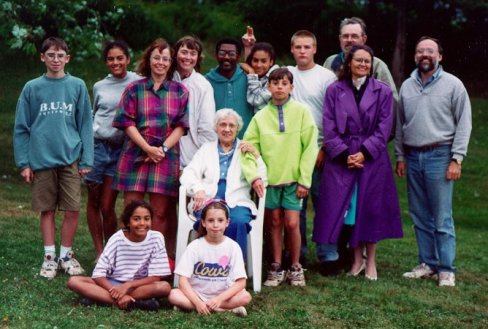 Through the
years, Jean saved his writings including his academic papers,
sermons, and prayers which were passed on to me (their son) in
1994. Although primarily of interest to family, including seven
grandchildren and ten great-grandchildren (in 2021),
his written work continues to be a link to his ministry and
Through the
years, Jean saved his writings including his academic papers,
sermons, and prayers which were passed on to me (their son) in
1994. Although primarily of interest to family, including seven
grandchildren and ten great-grandchildren (in 2021),
his written work continues to be a link to his ministry and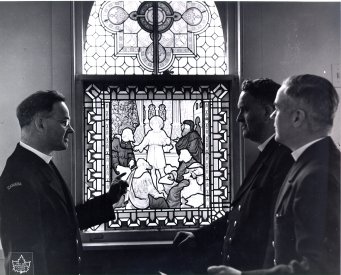 the lives he touched.
the lives he touched.
| HomePort Quick List | Scotts@HomePort | Search HomePort | Send e-mail to: HomePort |
| . |